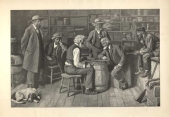The Checker Maven
The World's Most Widely Read Checkers and Draughts Publication
Bob Newell, Editor-in-Chief
Published every Saturday morning in Honolulu, Hawai`i
Noticing missing images? An explanation is here.
Happy Holidays to All

During the winter holiday period, The Checker Maven closes its offices for a week or two, and staff spend time with their families. But that doesn't mean that checkers go off the agenda. Not at all! It's our wont to publish an interesting and entertaining checker problem or two, so our loyal readers can have a little extra checker enjoyment during this festive time of year. And when we look for a special checker problem, we inevitably turn to the master himself, Tom Wiswell; and what better choice than a problem he calls New Year's Resolution. Here's the position.
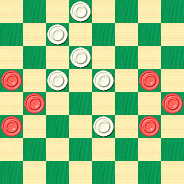
BLACK
Black to Play, What Result?
B:B9,12,13,16,17,20:W10,18,19,23,27,31.
The position comes from a game in a New Year's Day tournament played in New York some decades back. As a holiday present, we'll give you a large hint: Mr. Wiswell, playing Black, won this game.
We would not say that this position is particularly easy, and in fact, it may use up a certain number of your holiday leisure hours. So please enjoy, but don't neglect your family time! When you've found your solution, click on Read More to see the full game, Mr. Wiswell's winning play, and KingsRow's computer analysis.![]()
Shearer's Cleaver
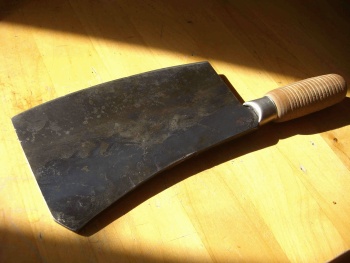
This week we return to our popular series taken from Willie Ryan's Tricks Traps & Shots of the Checkerboard, a true all-time classic of checker literature. We feature a setting called Shearer's Cleaver in which Willie shows us how, after a misstep by the Black side, White mercilessly chops him down. Let's let Willie narrate the tale.
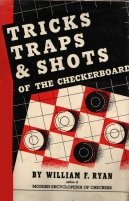
"The masters often get into spirited controversies over who was first to show a particular line of play or shot. This Bristol Cross trap is a case in point. D. G. McKelvie, of London, England, claimed he was first to show it, but H. F. Shearer, of Scotland, published it first in 1892 and received credit for it. If an analyst has in mind a certain new play or analysis, but does not publish it, he has no legal claim of authorship or priority to it. It has been demonstrated time and again that champions often independently discover the same play and 'cooks,' but wishing to use these discoveries in future matches and tournaments, they keep their play under cover. More than one champion has yelled 'foul' when another has published a play or received credit for an analysis that he thought nobody else knew!
This is the way you start:
| 11-16 | 7-10 | 5-14 |
| 23-18 | 22-17 | 29-25 |
| 16-20 | 9-13 | 3- 7 |
| 24-19 | 27-23---A | 31-27 |
| 10-14 | 13-22 | 7-11---B. |
| 18-15 | 25- 9 | See the |
| diagram. |
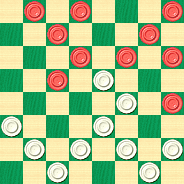
WHITE
White to Play and Win
W:W32,30,28,27,26,25,23,21,19,15:B20,14,12,11,10,8,6,4,2,1.
A---An alternate trap can be set here by 26-22. Now 5-9, 30-26, 2-7, 27-23, 7-11, 32-27, etc., will end in a draw; but if after 26-22 at A, black replies with 2-7, white explodes with: 19-16, 12-19, 27-24, 20-27, 32-16, 10-19, 17-10, 7-14, 22-17, 13-22, 25-2, and white wins. H. F. Shearer.
B---Starts the stroke. Black's only draw move is: 1-5*, 25-22, 20-24*, 27-20, 7-11, 22-17 (not 22-18, 6-9, 15-6, 11-16, 20-11, 8-31, black wins), 11-27, 32-23, 6-9, 17-13, 10-15, 19-10, 14-17, 13-6, 2-9, 21-14, 9-27. D. G. McKelvie vs. James Searight."
Can you find the winning method, or will this problem take a slice out of you? Take a cut at it, and when you've hacked out the answer, click on Read More for the sharp and incisive solution.![]()
Always Drink Water

The primary offices of The Checker Maven are, as we've noted from time to time, in Santa Fe, New Mexico, in the American Southwest. Santa Fe can be described as "high desert" as it lies over 7,000 feet above sea level and the climate is rather dry. It's a place where the altitude and the dryness combine to make dehydration a real issue. Tourists often complain of headaches, not realizing that they need to drink a lot of water to replace water loss silently taking place at a rate to which they are not accustomed.
Today, in our monthly Checker School column, we are asking you to "drink water" in a different manner. The topic of our lesson is Drinkwater's Draw, attributed unsurprisingly to old-time checkerist F. W. Drinkwater. It's another of those eminently practical maneuvers that will save you many a game--- if you know how. Here's the basic position.
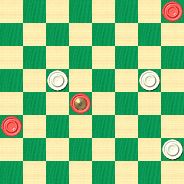
WHITE
White to Play and Draw
W:W14,16,28:B4,K18,21.
Black is clearly in the lead here, having a King and two men to White's three men, and one of the White men is under attack. Would you be able to save this one?
Give it a try, but if it's too much to swallow, click on Read More to drink in the solution, a sample game, and copious notes.![]()
We're Now Four Years Old

This week the Checker Maven completes four years of on-time regular weekly publication, with not a single missed edition. It's yet another waypoint we never knew we'd reach, but it's a certainty that our unprecedented success is owed completely to our thousands of regular weekly readers.
While no one can say what the future will bring, it's our intention to keep on publishing for as long as we're able, and, if all goes as planned, you'll find a new edition of the Checker Maven online for your checker pleasure every Saturday morning for many years to come. Thank you one and all for your support and encouragement.
And now, in celebration, we present below a new short story starring a new character: Benny, of Newark, New Jersey, way back in the 1940s. We hope you enjoy today's checker tale.![]()
An Afternoon at Benny's: Newark, 1946
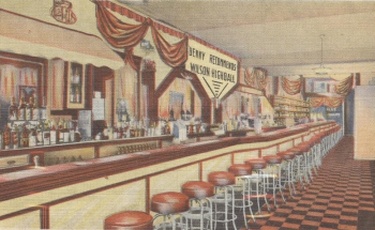
Mid-afternoon on a weekday was usually quiet at Benny's Bar, a long, lazy lull when lunch was over and the factories had not yet let out the crowds of workers seeking a beer or two before taking the streetcar home.
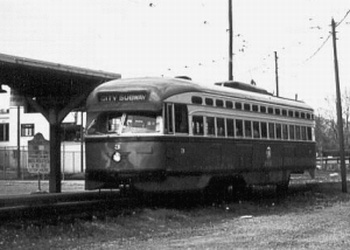
The atomic bombs had fallen on Japan last year; the war was over and times were good in Newark, as the economy returned to a peacetime footing. Though Benny was getting older, and feeling it more each day, he enjoyed running his bar, conversing with his customers, and keeping the place tidy; but above all, Benny enjoyed his checkers. Through the hard times of the '30s, the even darker years of the war, and now into a new era of peace and prosperity, Benny would take on anyone, sitting at his corner table and putting as much as five or ten dollars on the line, winner take all.
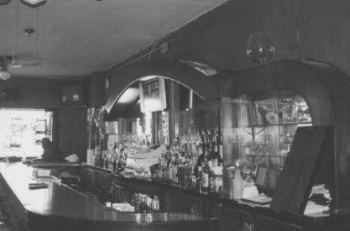
Benny sipped his Ballantine's, idly moving the checkers around the board, waiting, as he often did at this time of day, for a customer to come in, and not being in a particular rush for that to happen. He was thinking about an endgame study he had seen in the Roseville Citizen, trying to absorb the play, when the front door of the bar opened and in came a dapper, 40-ish man, dressed neatly in a suit, sporting a trim moustache and slicked-back hair.
“I'm looking for a beer,” the man called. “Anyone here?”
“Back here,” replied Benny from the corner. “You like a Ballantine's on draught? I'll get it for you.”
“Sure, a Ballie's is fine,” said the man, glancing back into the corner from which Benny's voice emanated. “So you're the barkeep...” and just then the man noticed the checkerboard on Benny's table.
“You play?” the man asked Benny. “I'm here in Newark for a few days, and we're between rounds over at the ...”

“I play a little,” Benny replied as he made his way behind the bar and drew a glass of beer from the row of taps along the top of the bar. It was Benny's usual come-on. “Care for a quick game while you drink your beer?”
“Well, sure,” the man replied, “but you ought to know...”
“Couple of bucks on the game?” Benny interrupted. “Just to give things a little more life; this afternoon's been pretty quiet.”
“Well, like I was saying,” the man resumed, “you really should know that....”
“OK, maybe five bucks then? You look like a real sport!”
The man seemed a bit annoyed at Benny's interruptions, and his face took on rather a different look. “How about a sawbuck?” he said in a determined voice. “That would sure liven things up for you if you're bored.”
Benny didn't hesitate. He never did. “Ten bucks it is!” he said. “Come on over to the table. Tell you what. It's nearly an hour 'til the factories let out their first shift and it starts to fill up in here. I'm a sport, too. You go ahead and take the blacks first, and we can play until someone wins.”

“That might not be so long,” the man mumbled, more or less to himself, as he took the glass of beer from Benny and went over to the checkerboard, where Benny joined him after refilling his own glass.
“Ah, the Roseville Citizen,” the man said, noticing Benny's newspaper. “You know I do some writing myself...”
“Yeah,” said Benny, getting impatient to start play, “I'm sure you send a lot of postcards, but how about let's play our game now.”
The man squared his shoulders and simply said, “I tried to warn you; now, have it your way.” And with that, he made his first move and the game began.
There was no further discussion as play went on, the two of them alternately making a move on the board and taking sips of beer from their glasses. Benny was taking his time on each move; his opponent was playing a sharp game, well above the level of play Benny usually encountered. He was secretly wondering if he had made a mistake in taking on this evidently skilled stranger.
The stranger, on the other hand, showed visible impatience, making his own moves rather quickly and with seemingly minimal reflection, as if Benny wasn't a player who needed to be taken very seriously.
The game went on for a good fifty minutes, when Annie, Benny's portly wife and a second bartender during busy hours, came through the back door. “Hey Benny, where are ya?” she said in a loud voice. “We'll be getting busy around here in a few ...”
“Ssh! Quiet hon, I'm in the middle of a tough one here,” Benny said in a vexed tone. “Let us be!” A cross look came over Annie, then she just shrugged her shoulders, put on her apron, and went behind the bar. A couple of factory workers had already made their appearance, expecting to be served their Ballantine's and Shaefer's.

The contestants exchanged a few more moves. Factory workers continued to stream in and some of them started to watch the game. There was surprisingly little banter; somehow, they sensed from Benny that he had a real contest on his hands and didn't want any disturbance or interruption. The stranger made another move. Benny looked at the board, then looked again, a puzzled expression on his face. Some few minutes passed. The dapper, suited man, growing more and more impatient, growled in exasperation, “Will you play already! I haven't got all....”
The man fell silent. He too stared intently at the board, his countenance changing by degrees from unsure to grim. Finally, Benny looked up from the board and said, “You're good, mister, real good, but you shoulda been more careful.” Then, with a surprisingly firm hand, Benny made his move.
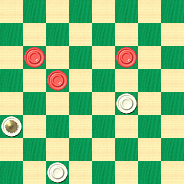
WHITE
White to Play and Win
W:W19,K21,30:B9,11,14.
For the conclusion of our story, the solution to the problem, and story credits, please click on Read More.![]()
A Thanksgiving Feast

We've often said in these columns that Thanksgiving is far and away our favorite holiday. It's distinctly American (and we're unabashed patriots), non-sectarian in celebration (even if not in origin), and a wonderful family event which we greatly enjoy each year.
As a special Thanksgiving treat to accompany your turkey and pumpkin pie, here's a checker problem that we found to be fascinating, in that it has two solutions: one very ordinary and prosaic, and one surprising and snappy. Take a look if you will:
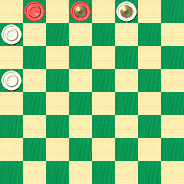
WHITE
White to Play and Win
W:W13,5,K3:BK2,1.
White is a man up and ought to win, but can you find the way that gets you to that second slice of pumpkin pie the fastest? Feast on our problem for a while, then click on Read More for your dessert, in the form of the surprising solution.![]()
Tommy Meets Marvin

It was a Saturday morning in the Florida fall, and as was usually the case, Tommy had rushed over to Uncle Ben's porch for his weekly checker lesson. Of course as you know by now, Uncle Ben wasn't really his uncle, but calling the kindly old gentleman "Uncle Ben" just seemed like the right sort of thing to do.
"So, Tommy, you must tell me all about it!" exclaimed Uncle Ben from his comfortable seat on the porch's outdoor sofa.

Tommy Wagner
Tommy couldn't wait to tell Uncle Ben his news--- Tommy had met professional checker star Marvin J. Mavin in person, and had played against him in a simultaneous exhibition at Tommy's grade school!
Marvin J. Mavin, as our regular readers are aware, is the team captain of the Detroit Doublejumpers, in the American Conference of the National Checker League. Marvin is well-known for his work in schools with the up-and-coming checkerists of the next generation. Marvin is also known as being, shall we say, somewhat of a character.
"Yes, Uncle Ben, I got to play in the simul against Marvin!" said Tommy excitedly. "First he gave a lecture to all the students and then workshops for our teams and ..."
"Whoa, slow down a bit, Tommy!" asked Uncle Ben. "That's rather a lot at once! Tell me first, what kind of impression did Marvin make on you?"

Marvin J. Mavin
"Well," replied Tommy, "he knew everything about checkers and there wasn't any question he couldn't answer! I'd sure like to be a great checker player like Marvin some day, although...." Here Tommy hesitated a little.
"Go on, Tommy," urged Uncle Ben.
"It's just that his hair looked like he ought to maybe, you know, wash it? And he did kind of smell a little like beer..."
"Ah yes," said Uncle Ben, "in my own professional playing days, we took a little more care with our image and the impression we made. Marvin is a fine checker player, but you'd be best advised not to imitate some of his, shall we say, less desirable characteristics. But enough of that; it's great that you got to play in the simul, so tell me about it."
"I got to play because I'm Captain of the Junior Varsity this year," said Tommy, "and that gave me a table at the simul. Would you care to go over the game with me?"
"Of course, Tommy," said Uncle Ben. "I imagine Marvin won? It would be tough even to get a draw against a seasoned professional."
"He did win," said Tommy, "and I don't feel bad about that at all. I was just happy to have a chance to play. Still, at one point I thought I might have gotten a draw. Here's how the game went."
11-15, 22-18, 15-22, 25-18, 12-16, 29-25, 9-13, 26-22, 16-20, 24-19, 5-9, 21-17, 8-12, 25-21, 4-8, 30-26, 1-5, 28-24, 8-11, 32-28, 11-16, 19-15, 10-19, 24-15, 16-19, 23-16, 12-19, 27-24, 20-27, 31-24, 7-10, 17-14, 10-17, 21-14, 2-7, 15-11, 7-16, 24-15, 3-7, 26-23, 16-20, 23-19, 20-24, 15-10, 6-15, 19-3, 24-27, 14-10, 9-14, 18-9, 5-14 (diagram)
"Look at this, Uncle Ben!" Tommy went on. "I had lost a man, but I thought that it still wasn't so easy for Mr. Mavin to win. But he played this great series of moves..."
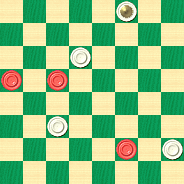
WHITE
White to Play and Win
W:B13,14,27:W28,22,10,K3.
"That's what makes him a top player," said Uncle Ben, "not missing an opportunity to bring home the win. But this is a familiar theme that is worthy of further study. Do you know where you went wrong, and do you understand now how Marvin was able to win?"
"Yes, sir, I do," said Tommy. "I know which was my losing move, and here's how Mr. Mavin got the win."
Are you as good as Marvin J. Mavin, and can you find the winning moves in the position shown below? Can you find and correct Tommy's losing move?
Give it some study, and when you've come up with your answer, click on Read More for the solution, a large selection of additional examples of this theme, and the conclusion to this week's story.![]()
Workman's Whizzbang

The workman shown above has a real whizzbang of a job ahead of him in restoring what's left of that automobile; but in this month's installment from Wille Ryan's Tricks Traps & Shots of the Checkerboard, we'll look at a whizzbang of a much different kind, attributed to a checker workman eponymously named Workman. Willie will tell us all about it.

"Take a really good look at this classic crossboard skirmish between Champion Herman L. Rudolph, of Pittsburgh, Pennsylvania, and E. E. Workman (former champion of Virginia), of Washington, D. C. It was played at the 1948 Cedar Point (Ohio) Master's Tourney, and shows how the benign gentleman from Virginia unexpectedly floored hard-hitting Herman with a bristling double-action flourish. Play:
| 10-15 | 22-18---A | 11-15---B |
| 24-20 | 15-22 | 20-16 |
| 15-19 | 25-18 | 8-12 |
| 23-16 | 8-11 | 30-26---4 |
| 12-19 | 17-13 | 6-10---D |
| 27-24 | 3-8 | 27-23 |
| 7-10 | 26-22 | 1-6---E |
| 24-15 | 9-14 | 29-25 |
| 10-19 | 18-9 | 14-17---F, |
| 21-17 | 5-14 | forming the |
| 11-15 | 32-27---2 | diagram. |
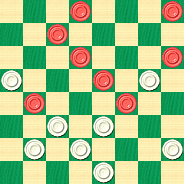
WHITE
White to Play and Win
W:W13,16,22,23,25,26,28,31:B2,4,6,10,12,15,17,19.
A---A distinctive departure from all orthodox play---1, but quite sound.
B---Splendidly played by black to here. The following is much stronger, but results in a draw only: 11-16, 20-11, 8-15, 29-25, 4-8, 27-24*, 1-5---C, 25-21, 14-18, 22-17, 18-22, 17-14*, 6-9, 13-6, 2-18, 21-17, 19-23, 24-19, 15-24, 28-19, etc. Wm. F. Ryan.
C---If 8-11 is moved, 22-18 will produce a draw at once; if 6-10 is used, then 25-21, 2-6, 22-17, 8-12, 30-25, will do it easily---3.
D---Against 14-17, white replies 27-24, 6-10* (17-21, 16-11, 21-25---5, 11-8, 4-11, 22-18, and white wins) and 13-9 catches the draw easily. If instead of 13-9 white takes the shot by 22-18, black scores this brilliant win based on a problem gem by Dr. Brown: 22-18, 15-22, 24-6, 12-19, 31-27!, 22-31, 27-24, 1-10, 24-6, 2-9, 13-6, 17-21*, 28-24, 4-8*, 24-20, 8-12*, 6-2, 31-26, 2-6, 26-22, 6-10, 22-18, 10-6, 18-15, 6-9, 15-11, 9-14, 12-16, 14-18, 16-19, 18-22, 19-23*, 22-18, 23-27, 18-23, 27-32, 23-19, 32-28*, 19-16, 11-15*, 16-12, 28-24, 12-16, 15-18*, 16-12, 24-19, 20-16, 18-14, 16-11, 14-10, 11-8, 10-7, 8-4, 7-3, 4-8, 19-15. The play in this note proves that there are losing shots as well as winning ones.
E---Against 14-17, white must play carefully to draw: 14-17, 23-18, 17-21,18-11, 21-25, 31-27*, 25-30 (nothing better)---6, 26-23, 19-26, 27-24, etc.
F---Asleep at the switch! Seemingly deceived by the blase appearance of the situation, Rudolph innocently walks into Workman's deadly trap. Of course, 14-18---7, 23-7, 2-20, 25-21, 6-10, would have nailed a draw."
1---32-27 is a good move here; with the text move, Black starts to get a small edge---Ed.
2---At this point, KingsRow thinks Black has a recognizable advantage, though certainly short of winning---Ed.
3---KingsRow actually prefers a move Willie didn't give, 8-12, in this position, for instance 8-12 25-21 14-18 22-17 19-23 24-20 18-22 17-14 22-25 21-17 25-29 and Black probably should be able to win---Ed.
4---16-11 would have been a likely draw here according to KingsRow---Ed.
5---Here 16-11 would be better but still is a probable loss----Ed.
6---Actually KingsRows finds 1-6 to be substantially better and likely winning! For instance, one continuation is 1-6 17-22 25-30 26-22 30-25 22-18 25-22 18-14 19-23 14-7 23-32 7-3 12-19 17-14 22-18 14-9 18-14 9-5 14-10 29-25 6-9 13-6 10-1 25-22 19-23 3-7 23-26 7-10 32-27 10-14 27-23 28-24 26-31 22-17 31-27 24-20 23-19 14-10 27-23 and the man on 11 can't be saved; Black Wins---Ed.
7---2-7 also draws according to KingsRow---Ed.
Can you, in a workman-like fashion, reproduce the win that Mr. Workman found here? Do your work, and then make easy work of it by clicking on Read More to see how a real crafstman does it.![]()
The Passing of a Legend

The Checker Maven notes with great sadness the passing of legendary checkerist Richard L. Fortman, on November 8, 2008, in Springfield, Illinois, at the age of 93. Though we never met Mr. Fortman in person, we exchanged emails with him at times, and he honored us a few years back by permitting us to publish his latest Switcher analysis in our columns.
Mr. Fortman might well have been the last of the great men of the heyday of checkers. As those days have passed, so too have its champions. Mr. Fortman was a master player, analyst, and writer; but above all he was a gentleman and the best of ambassadors for our game. A man such as Mr. Fortman cannot be replaced. A page has been turned in the history book of checkers, never to be turned back again.![]()
Review Your Work

Music teachers point out the classic wisdom that one's technique in playing a musical instrument either improves or falls back; it never stays constant. We know this to be true as well of our skills in many human endeavors, be it business, the arts, or our game of checkers. Constant practice and study are required if we are to maintain our technique, let alone move it forward.
Today's lesson in our Checker School series provides us with an important opportunity to review our work. The position shown below should be familiar to most checkerists, and certainly so to regular readers of our weekly columns. We've seen this before, and more than once.
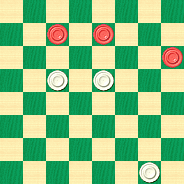
WHITE
White to Play and Win
W:W14,15,32:B6,7,12.
If you don't recall how to win this one, now's the time to brush up and review the method, as it's an eminently practical example, sure to arise in your own play. Think back and see if you can solve it; then click on Read More for the solution, notes, and sample games.![]()
The Checker Maven is produced at editorial offices in Honolulu, Hawai`i, as a completely non-commercial public service from which no profit is obtained or sought. Original material is Copyright © 2004-2025 Avi Gobbler Publishing. Other material is public domain, as attributed, or licensed under Creative Commons. Information presented on this site is offered as-is, at no cost, and bears no express or implied warranty as to accuracy or usability. You agree that you use such information entirely at your own risk. No liabilities of any kind under any legal theory whatsoever are accepted. The Checker Maven is dedicated to the memory of Mr. Bob Newell, Sr.

